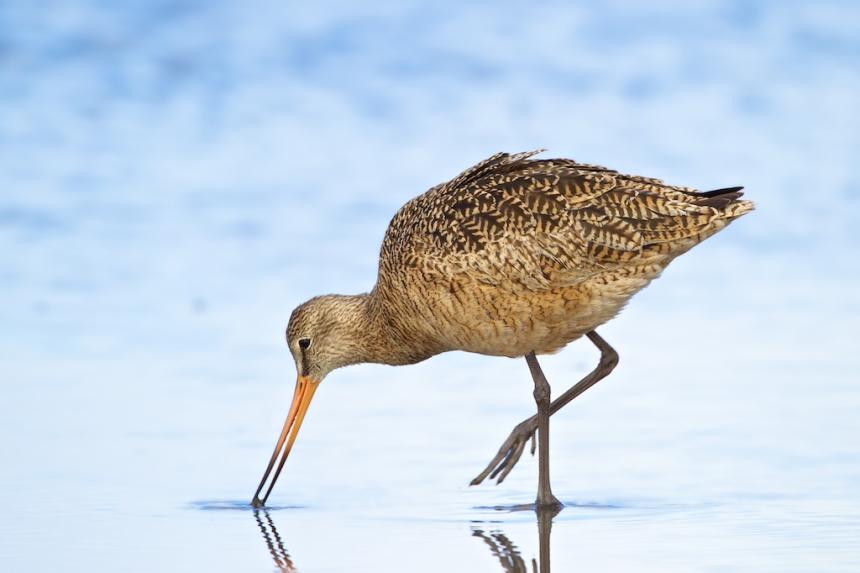Moderate
The Washington population of marbled godwits is very small, and most of the state’s population occurs in very localized areas of Grays Harbor and Willapa Bay. Those attributes make the marbled godwit vulnerable to oil spills or other actions that would degrade or impact its habitat. Human disturbance currently does not appear to be a concern.
Description and Range
Physical description
The marbled godwit is one of the largest shorebirds in the world, measuring about 18 inches in length. It has a long, generally upcurved yellow bill that is darker on the lower half to the tip. The bird is overall light brown with dark mottling above and barring below -- breeding plumage is more mottled and the barring is rust-colored compared to winter or juvenile plumage.
Ecology and life history
In Washington, the marbled godwit is typically associated with tidal mudflats and sandflats, but small numbers at times also use coastal beaches. In the Columbia Basin, where it is very uncommon during migration, short grass areas and shorelines are used.
In coastal areas, they feed on a variety of intertidal invertebrates that they extract from mudflats.
They nest in native prairie grasslands, wet meadows and similar cover types.
Geographic range
Three separate breeding regions are known in North America and both fedoa and beringiae subspecies likely occur in Washington. The beringiae subspecies breeds in a small area of the Alaska Peninsula.
The estimated global population is 140,000 to 200,000 individuals, and this includes the beringiae population of about 2,000, which is thought to overwinter between Washington and California. The fedoa population from the northern Great Plains overwinters between central California and coastal Mexico.
In Washington, marbled godwits occur primarily in northern Willapa Bay (they roost at the Tokeland Marina) and southern Grays Harbor. Considered a very rare visitor several decades ago, marbled godwit abundance in Washington has increased steadily and some recent counts have exceeded 1500 birds. The overwintering population in Washington is substantially farther north than the more contiguous distribution of the population that extends from Humboldt Bay, California, south into Mexico.
For a map of worldwide distribution and other species' information, see NatureServe Explorer and the International Union for the Conservation of Nature Red List.
Climate vulnerability
Sensitivity to climate change
Moderate
Marbled godwits may experience some phenological sensitivity to increases in air temperature, as warmer temperatures could alter their migration timing and length of overwintering season in Washington. Temperature-induced alterations in migration timing may also affect breeding season timing and productivity. Overall sensitivity will be higher due to their dependence on intertidal sand and mudflats as foraging sites, which may decrease in extent due to sea level rise and coastal inundation. Due to their long legs, marbled godwits may be able to withstand coastal sea level changes and forage in deeper waters.
Exposure to climate change
Moderate
- Increased temperatures
- Sea level rise
Conservation
Conservation Threats and Actions Needed
Fish and wildlife habitat loss or degradation
- Threat: Oil spill that impacts foraging area and fouls foraging birds.
- Action Needed: Maintain spill response effectiveness.
Resource information collections needs
- Threat: Small population size.
- Action Needed: Clarify subspecies occurrence in Washington.
See the Climate vulnerability section for more information about the threats posed by climate change to the marbled godwit.
Resources
References
Buchanan, J. B. 2005. Marbled Godwit (Limosa fedoa). Page 149 in T. R.Wahl, B. Tweit, and S.G. Mlodinow (Eds.), Birds of Washington: status and distribution. Oregon State University, Corvallis, OR, USA. 436 pp.
Gratto-Trevor, C. L. 2000. Marbled Godwit (Limosa fedoa). The Birds of North America 492: 1-24.
